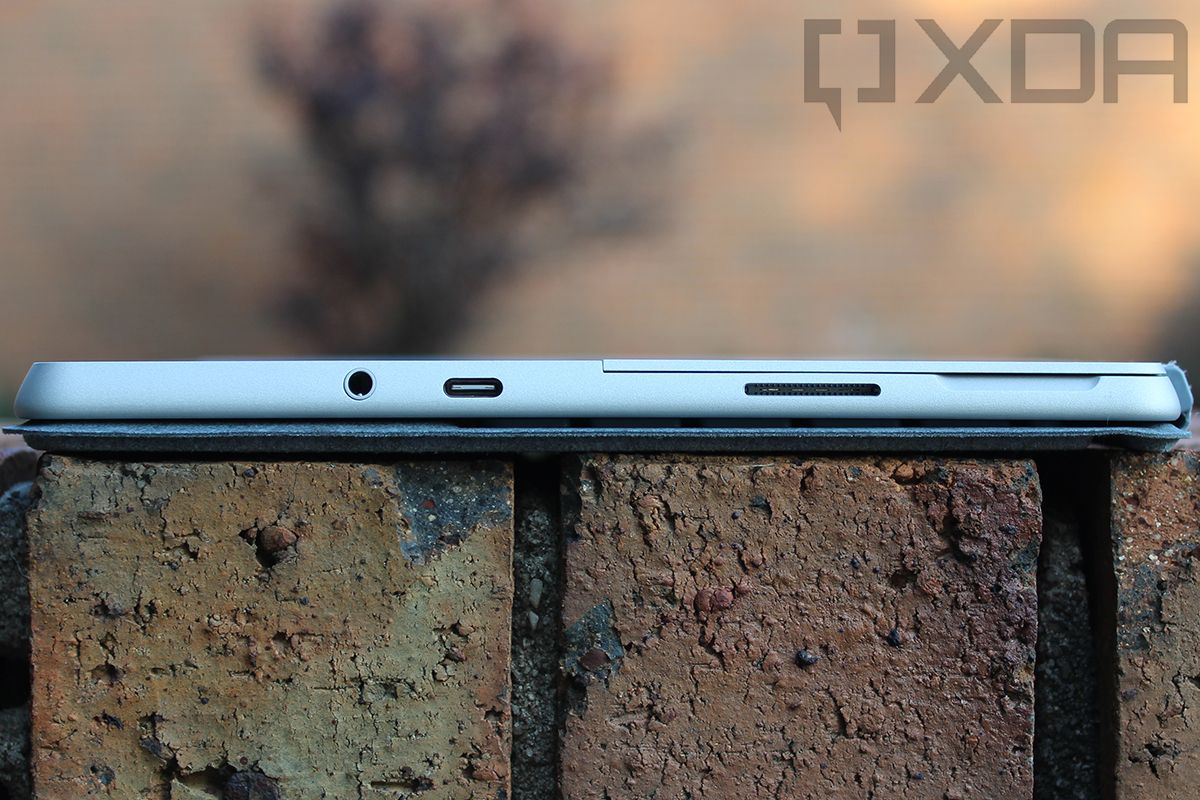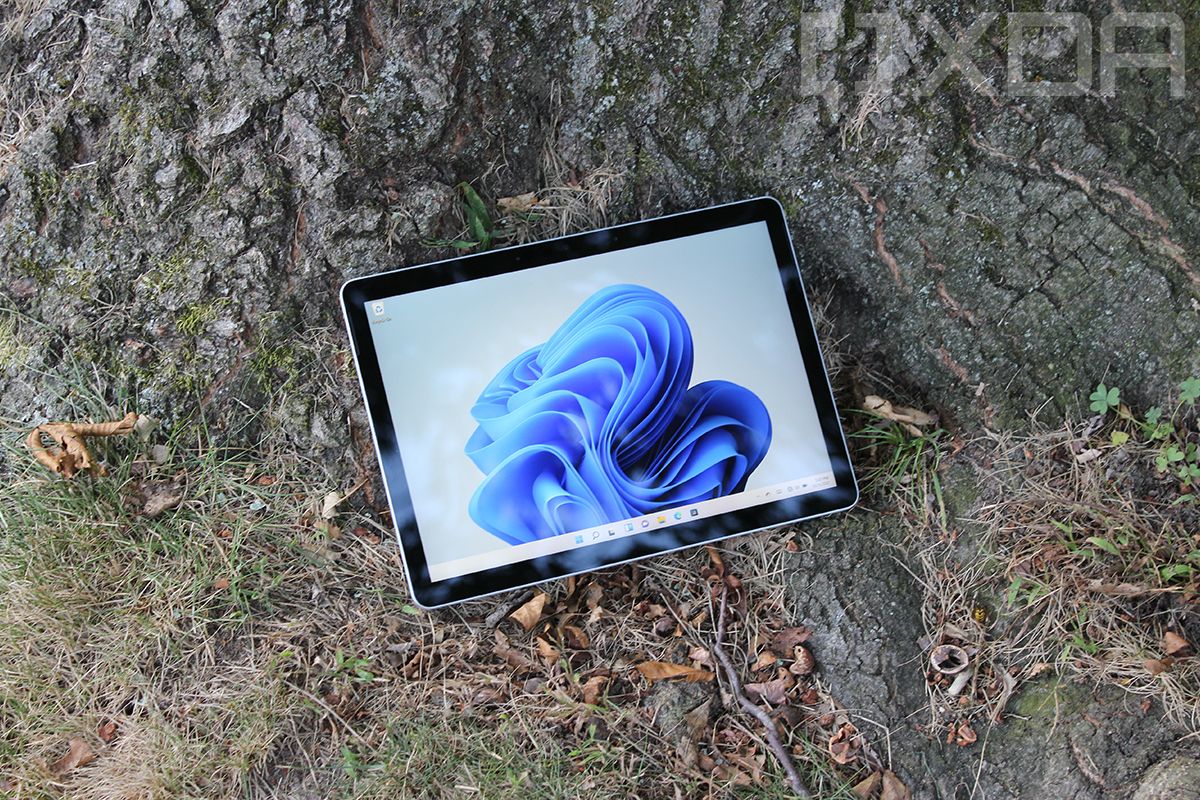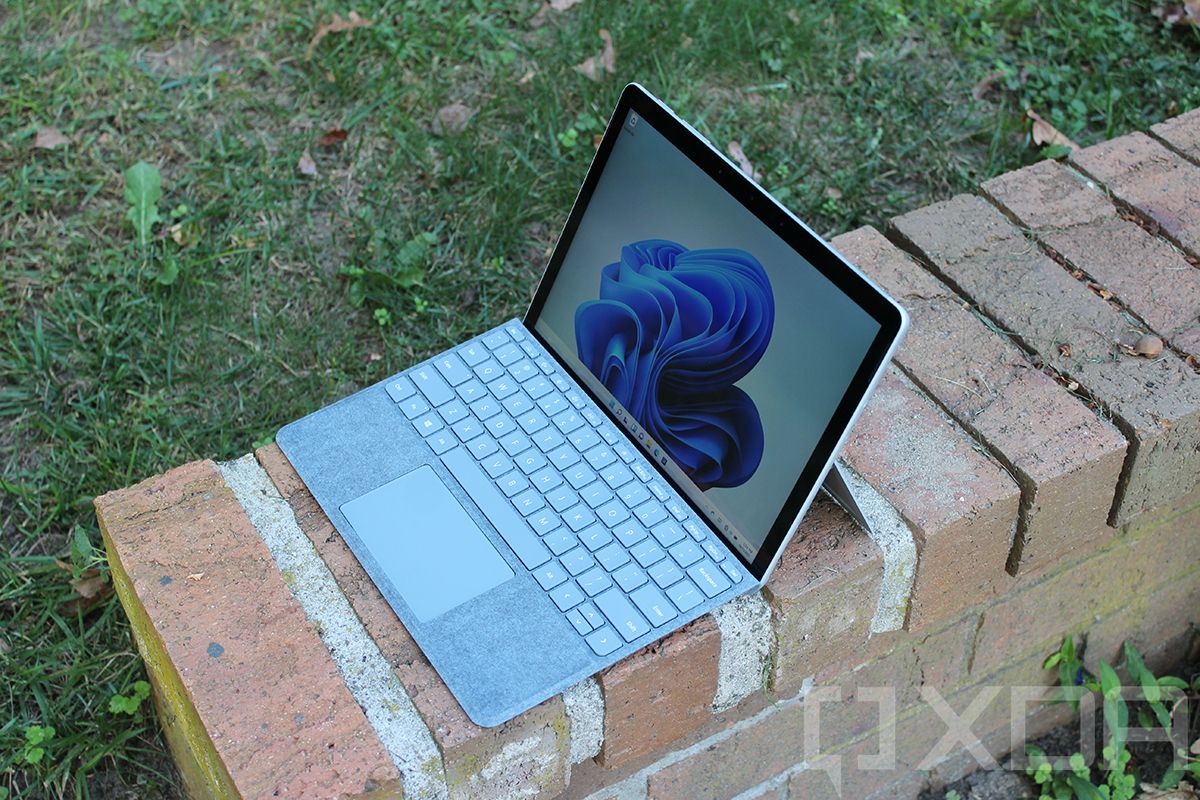Microsoft Surface Go 3 review: It’s sneaky decent
Microsoft announced a bunch of new hardware to coincide with its Windows 11 launch. The Surface Laptop Studio and the Surface Pro 8 were the hero devices, but then there’s the Surface Go 3. The Surface Go 3 doesn’t come with a new 120Hz display, and in fact, it doesn’t even support the haptic feedback in the new Slim Pen 2. With this product, it’s very much a spec bump in an ecosystem of redesigned products.
That’s not a totally bad thing; it just makes the Surface Go 3 the least exciting of the new products, a fact that even Microsoft wasn’t shy with being up-front about. The spec bump is actually a pretty good one, and the product did get a semi-redesign in its last iteration. This is also meant to be the budget product in the Surface lineup, so if it doesn’t get all of the bells and whistles right away, it’s not super surprising.
Navigate this review:
- Design: Traditional Surface design
- Display: An improvement over the original model
- Keyboard: The Surface Go 3 keyboard feels solid, but small
- Performance: 10th-gen Intel CPUs, up to a Core i3
- Conclusion: Should you buy the Surface Go 3?
Surface Go 3 Specs
| CPU | Dual-core Intel Pentium Gold 6500Y processor Dual-core 10th Gen Intel Core i3-10100Y processor |
|---|---|
| Graphics | UHD Graphics 615 |
| Display |
|
| Chassis | 9.65” x 6.9” x 0.33” (245 mm x 175 mm x 8.3 mm), 1.2 lb (544 g) |
| Memory | 4GB or 8GB LPDDR3 |
| Storage |
|
| Security |
|
| Sensors |
|
| Keyboard | Surface Go Signature Type Cover Surface Go Type Cover |
| Pen | Microsoft Pen Protocol (MPP) |
| Battery |
|
| Ports |
|
| Cameras, video, and audio |
|
| Connectivity |
|
| Material | Magnesium |
| Color | Platinum |
| OS | Windows 11 Home in S mode |
| Price | $399.99 / $549.99 / $629.99 |
There are three models, priced at $399.99, $549.99, and $629.99. The entry-level model includes an Intel Pentium Gold 6500Y, 4GB RAM, and 64GB eMMC storage. That’s not the one you want, as it’s just low on RAM and offers slower storage. The mid-tier one has the same Pentium Gold, but with 8GB RAM and a 128GB SSD. Then, the highest-end one has a Core i3, 8GB RAM, and a 128GB SSD. That Core i3 model is the one that Microsoft sent me for review, so whatever take you get out of this, it’s not a review for the Pentium Gold model. Unlike other laptops that I often review, I can’t speak to other configs of this as it has hardware that I’ve never used. There’s no baseline for me. Alternatively, if I’m using something with a Core i7, I have a good idea of what a Core i5 configuration would be like.
I will tell you that you shouldn’t spend money on a Windows PC with 4GB of RAM or 64GB of eMMC storage, let alone both. I look at the $549.99 model as the bare minimum for the product, and keep in mind that you’ll still need to buy the keyboard and pen, so your total is probably going to be over $800 with sales tax and such.
Design: Traditional Surface design
I feel like we’re moving into the third era of Surface design. The first included products like the Surface RT, Surface Pro, Surface 2, and Surface Pro 2. While they were made of magnesium, they were only available in black (except for the Surface 2), they had a completely different Surface Connect port, and they used a different pen technology. The Surface Pro 3 started the second era, including products like the Surface Book and Surface Go. We’re starting to see a new era that began with the Surface Pro X, as Microsoft moves toward more aluminum products.
The Surface Go 3 remains in that second era of Surface design. Unlike the larger Pro member of the family, it’s still made out of magnesium, coming in the traditional Platinum color. The Surface Pen still magnetically attaches to the side, and that pen still requires a AAAA battery.
It has a kickstand that comes back, and it has the chrome-colored Microsoft logo stamped right in the middle of it. Underneath that kickstand, you’ll find the microSD expansion slot, something that’s also being removed in newer Surface devices.
The Surface Go 3 is the thinnest and lightest for its price point.
And no, I don’t use the included Surface Connect charger. Seriously, it’s so disappointing that the Surface Connect port is still on the new generation of Surfaces. Life is so much easier if you can just use the same USB Type-C charger for everything.
Here’s something that’s super important when it comes to the design though. This thing weighs in at a third of an inch thick and 1.2 pounds. That’s something that simply doesn’t exist elsewhere at this price point. Sure, you really should take a step over the base model here, but for something that’s meant to be taken on the go (that’s why Go is in the name), very little gets the job done better. It’s not for photo and video editing; it’s meant for portability.
Display: An improvement over the original model
The Surface Go 3 has a 10.5-inch 1,920×1,280 display and it’s actually a half-inch bigger than the original Surface Go. This was an improvement that was in the Surface Go 2, and that half-inch makes a big difference. By fitting the bigger display in the same chassis, the bezels are smaller and the product just feels more modern.
At 220ppi, it’s actually got a higher pixel density than you’d find on the Surface Laptop Studio. I really do like the display on the product, even if Microsoft does refuse to give up its overly-glossy screens that can be hard to use in direct sunlight.
The Surface Go 3 screen feels like something you'd find on a premium PC.
Interestingly, the contrast ratio in my testing didn’t quite make it to the 1,500:1 that’s on the spec sheet, although I couldn’t notice any difference with my naked eye. Brightness maxed out at 421.3 nits.
Let’s talk about the webcam for a second. The Surface Go 3, like its predecessors, uses a 5MP webcam that can record 1080p 30fps video. While working from home is a concept that has seen a boom in the last year and a half, many laptops are still shipping with 720p webcams, a real shame.
But this isn’t just a tablet with a 5MP webcam. It’s a tablet with a 5MP webcam that starts at $400, something that you’re really not going to find elsewhere. I haven’t always praised Microsoft’s hardware. However, this company should be praised for using FHD webcams since 2014 (not in the Surface Laptop, oddly). The funny thing is that before everyone started working from home 18 months ago, no one cared about webcam quality, which is why we saw so many laptops with cameras under displays, and even some hidden in keyboards and such. 18 months later, companies are still scrambling to rework products with better webcams, but companies like Microsoft haven’t had to do that.
Keyboard: The Surface Go 3 keyboard feels solid, but small
The Surface Go Type Cover hasn’t changed since the original model, and it uses a different connector from the Surface Pro. This is notable, because for Surface Pro 1 – 7+, Surface RT, and Surface 2, they all used the same connector. The Surface 3 got a different one, the Surface Go series has its own, and there’s a new one for the Surface Pro 8 and Surface Pro X.
I actually quite like the keyboard. The keys feel sturdier than they do on the latest Surface Pro keyboards, and it’s comfortable to type on. What you do need to know is that this is not a full-size keyboard. Given the small size of the product, there’s only so big the keys can be. As long as you can get used to it, it’s quite pleasant for an attachable keyboard on a tablet.
Microsoft hasn’t changed up its colors at all, so it comes in colors like Platinum, Poppy Red, Ice Blue, and Black. The Redmond firm sent Ice Blue with my review unit. It’s worth noting that if you get Black, you won’t get Alcantara fabric coating it, which actually saves you about $30.
The Precision touchpad is fine, and it’s way better than what you’d find on the new Surface Pro Keyboard. The pain point with the Surface Pro is that no matter how lightly you press it, it makes a loud clicking noise. It’s actually a strange thing, since it wasn’t present in previous designs of the product. So, since the Surface Go hasn’t been redesigned, that annoying touchpad isn’t an issue.
Performance: 10th-gen Intel CPUs, up to a Core i3
I was a bit taken aback by how up front Microsoft was about the Surface Go 3 just being a spec bump. It’s not something that you see often, and I appreciate it. The product uses either a Core i3-10100Y, or in the base model, a Pentium Gold 6500Y. This replaces the Core i3-8100Y and Pentium Gold 4425Y in the Surface Go 2, and the Pentium Gold 4415Y in the original model.
There haven’t been any crazy impressive jumps here. Frankly, the biggest change was introducing the Core i3 model with the Surface Go 2, as the Pentium Gold in the original one was virtually unusable. But still, even with the new 10th-gen chips, these are 14nm processors from the Amber Lake family, and built using the same architecture that Intel had used for years before it moved to 10nm.
With any product in this entry-level price point, there’s a weird mix of compromises. As I mentioned, there’s a lot with the Surface Go 3 that’s unique at this price, mainly that it’s ultra-portable. The compromise is that the two least expensive models have a Pentium Gold, and when you go beyond that, you’re still stuck with a Core i3. Then you have a product like the Surface Laptop Go. The Surface Laptop Go comes with a Core i5 in all configurations, but it makes compromises elsewhere, such as with its lower-resolution screen.
Ultimately, I think the Surface Go 3 has to fill a niche for you. This is absolutely not something that you’ll plan on editing photos on. Not only can’t these Y-series chips handle that properly, but the screen is too small. That’s just not who this machine is meant for.
Instead, it’s aimed at people who want a Windows tablet that they can take on the go, the iPad Air of Windows, if you will. The hardware is great for productivity, as long as you’re not going split-screen, as it gets cramped. But as a writer, the full-screen writing experience is immersive on the smaller display.
Let’s also talk about Windows 11 on this thing. The new OS comes with all-new improvements for tablets, such as swipe gestures that are already familiar from Precision touchpads. It makes the device a lot easier to use without the keyboard attached. It’s a pretty cool little device for apps like OneNote and Microsoft Whiteboard.
For benchmarks, I used PCMark 10, 3DMark, Geekbench, and Cinebench.
| Surface Go 3 Core i3-10100Y |
Surface Go Pentium Gold 4415Y |
Surface Laptop Go Core i5-1035G1 |
|
|---|---|---|---|
| PCMark 10 | 2,631 | 1,755 | 3,139 |
| 3DMark: Time Spy | 392 | 205 | 409 |
| Geekbench | 926 / 1,786 | 401 / 909 | 1,180 / 3,430 |
| Cinebench | 620 / 1,220 | 321 / 632 | 1,060 / 2,581 |
As far as battery life goes, I got between three and five hours of usage on recommended power settings. I don’t always find that screen brightness makes as much of a difference as this, but I got just over three hours on average on 100% brightness, and then just under five hours at 50% brightness. Keep in mind that the Surface Go 3 does have a fairly small battery at 28Wh.
Conclusion: Should you buy the Surface Go 3?
Microsoft is at a point where it has a Surface for everyone. If you want a tablet with a pen, there’s the Surface Pro. For a laptop, there’s the Surface Laptop; however, if you need more power than you’d get from an ultrabook, there’s the Surface Laptop Studio. If you’re on a budget, there are entry levels of both with the Surface Go and Surface Laptop Go.
The product has to fit into your niche; you should never try to make your niche fit the product. For example, you need a new computer and you’ve decided you’re going to spend around $750 (including tax, accessories, extended warranty, etc.). There are a lot of options out there, and the Surface Go 3 is one of them assuming you’re buying the pen and keyboard. Now you have to ask yourself some questions. Are you looking for a traditional laptop or a tablet? Which compromises are you willing to make in order to get the features that you care about?
It’s easy to love the Surface Go 3, as long as you’re looking for a lightweight 10.5-inch tablet running Windows. If you’re looking for a cheap laptop, you really should be looking elsewhere.
The post Microsoft Surface Go 3 review: It’s sneaky decent appeared first on xda-developers.
from xda-developers https://ift.tt/2Z91m3T
via IFTTT












Aucun commentaire: